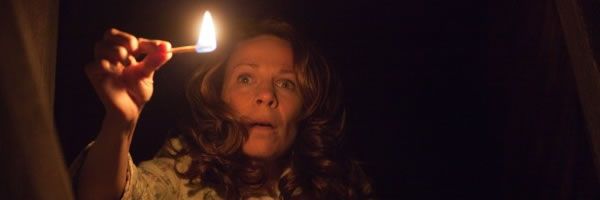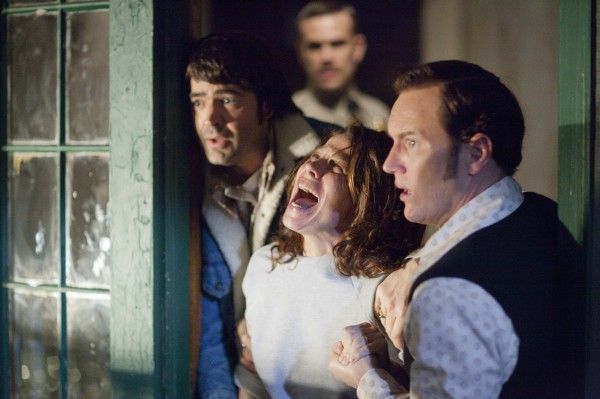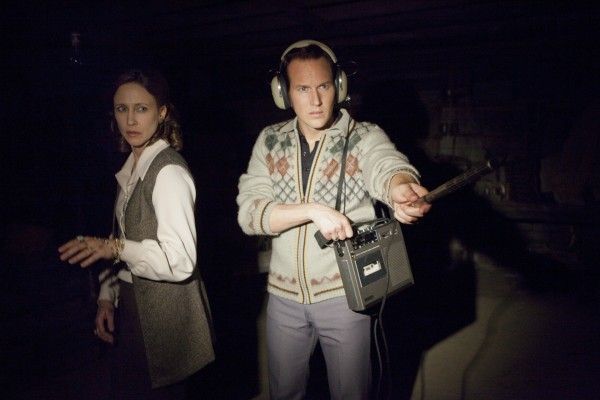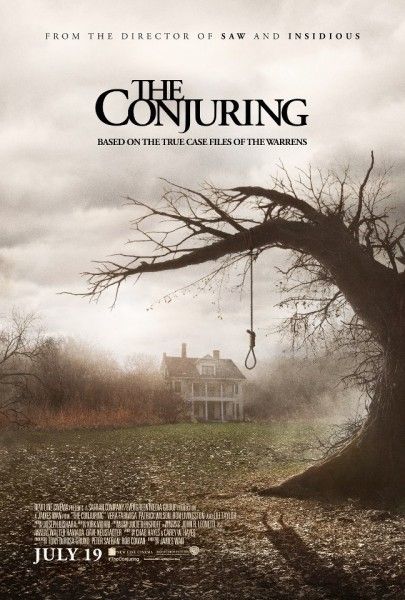Director James Wan and I have a disagreement on the meaning of the word "malevolent." His new film, The Conjuring, features an opening crawl that says the events we're about to see are based on the true story of the most malevolent case in the files of paranormal investigators Ed and Lorraine Warren. The case is so sinister that it's been kept secret until now. With this kind of billing, I expect something truly horrific and upsetting. But for Wan, "malevolent" is the equivalent of demons pulling supernatural tricks on a helpless family. The film features excellent performances and thoughtful cinematography that evokes the time period of the story, but Wan's definition of horror continues to rely on stale spooky images. His strongest asset is the Warrens, but the malevolence on display becomes redundant and annoying until the third act when Wan is finally able to tap in to true terror.
In 1971 in Harrisville, Rhode Island, the Perron Family began experiencing strange and unsettling phenomenon at a home they bought at auction. Primarily, the women of the house, mother Carolyn (Lili Taylor) and daughters Cynthia (Mackenzie Foy), Christine (Joey King), Nancy (Haley McFarland), and Andrea (Shanley Caswell) begin noticing strange sounds, phantoms, banging doors, and a variety of other occurrences that seem like irritating pranks. Eventually, the unexplained phenomenon becomes too much for the Perrons to bear, and Carolyn seeks out the help of Ed Warren (Patrick Wilson), a certified demonologist recognized by the Catholic Church, and his wife Lorraine (Vera Farmiga), a clairvoyant. The Warrens come to the home to find the source of the disturbance, and dispel the "inhuman spirit" before it claims the family.
The Conjuring could almost play as a spin-off of Wan's last film, Insidious. A family, particularly the mother, is continually startled by ghostly imagery. The family calls on the help of someone who can communicate with the other side, and that person comes with a team and equipment to monitor the paranormal activity (Conjuring has the nice touch of going lo-tech with old film cameras, big microphones, and flashbulb photography triggered by temperature drops or trip wires). Also like Insidious, Wan isn't content with just one ghoul, and goes with a more-is-better philosophy rather than trying to develop a single antagonist with a clear personality. He also features old horror standbys like creepy dolls, a decomposing old woman/witch, birds flying at the windows, and plenty of jump scares. Wan knows how to build tension and jolt his audience, but he can't truly unsettle us because we've seen almost everything in his bag of tricks. When birds started ramming into the house, my immediate response was, "Thank you, Mr. Wan. I too have seen The Birds."
By employing these old devices, the "malevolence" lacks power because Wan can never take us beyond the comfort of what we've already seen before, and a creepy doll doesn't build stakes. It's a creepy doll. The last thing horror movies should do is pacify the audience. We fear what we don't understand, but we've seen other horror movies, and so we almost always know what Wan is ready to throw at us. Although The Conjuring is terrific at evoking the 1970s and the horror movies of the time period, the scares don't feel classic, but tired. It doesn't matter that this is based on "true events". As a horror story, we've seen this before, and we saw it from Wan only three years ago when Insidious came out.
The only thing keeping The Conjuring from feeling completely stale are the Warrens. They're intriguing figures not only because of the great performances from Wilson and Farmiga, but because they're willing to be skeptical. If the problem is bad pipes and loose floorboards, they'll say so. They're not scam artists or people who have bought into their own bullshit. Wan clearly establishes them as the real deal, and they give the Perrons’ haunting some much-needed gravitas as the script gets painfully redundant with the inhuman spirit constantly annoying the family by closing doors, locking them in rooms, throwing pictures off the wall, and other mischievous activity that's supposed to break down their mental barriers. We can understand why the Perrons would be terrified, but we rarely share their terror because, again, we’ve already visited this haunted house.
If anyone comes out of The Conjuring showing they're afraid, it’s Wan. He's a director who doesn't push his audience into the unexpected. His technical execution is solid, and he has a good sense of atmosphere, but the room is always filled with the same toys. There are brief moments when The Conjuring breaks free of the familiar and Wan can terrify us with something we didn't see coming (unfortunately, one of the trailers spoiled what could have been among the best scares in the movie). But most of the time, we know what's going to make us jump, but the director doesn't know how to make us feel dread. I hope one day Wan faces his fears, and abandons the exhausted imagery and clichés that permeate his horror films.
Rating: C-




